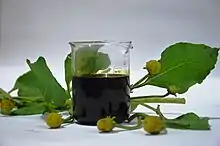Acmella oleracea
Acmella oleracea is a species of flowering herb in the family Asteraceae. Common names include toothache plant, Szechuan buttons,[2] paracress, buzz buttons,[3] tingflowers and electric daisy.[4] Its native distribution is unclear, but it is likely derived from a Brazilian Acmella species.[5] A small, erect plant, it grows quickly and bears gold and red inflorescences. It is frost-sensitive but perennial in warmer climates.
| Acmella oleracea | |
|---|---|
 | |
| Scientific classification | |
| Kingdom: | Plantae |
| Clade: | Tracheophytes |
| Clade: | Angiosperms |
| Clade: | Eudicots |
| Clade: | Asterids |
| Order: | Asterales |
| Family: | Asteraceae |
| Genus: | Acmella |
| Species: | A. oleracea |
| Binomial name | |
| Acmella oleracea (L.) R.K.Jansen | |
| Synonyms[1] | |
| |
Its specific epithet oleracea means "vegetable/herbal" in Latin and is a form of holeraceus (oleraceus).[6][7]
Culinary uses
For culinary purposes, small amounts of shredded fresh leaves are said to add a unique flavour to salads. Cooked leaves lose their strong flavour and may be used as leafy greens. Both fresh and cooked leaves are used in dishes such as stews in northern Brazil, especially in the state of Pará. They are combined with chilis and garlic to add flavor and vitamins to other foods.[8]
The flower bud has a grassy taste followed by a strong tingling or numbing sensation and often excessive salivation, with a cooling sensation in the throat.[8] The buds are known as "buzz buttons", "Sichuan buttons", "sansho buttons", and "electric buttons".[9] In India, they are used as flavoring in chewing tobacco.[9]

A concentrated extract of the plant, sometimes called jambu oil or jambu extract, is used as a flavoring agent in foods, chewing gum, and chewing tobacco.[10][11][12][13] The oil is traditionally extracted from all parts of the plant.[10] EFSA and JECFA reviewed a feeding study in rats and both authorities recognized that the no adverse effect level for spilanthol was 572 mg/kg b.w./day, yielding a safe dose of spilanthol of 1.9 mg/kg b.w./day, or 133.5 mg/70-kg-male/day, 111 mg/58-kg-female/day, or 38 mg/20-kg-child/day.[12][13]
Jambu extract as a flavoring agent is described as having a citrus, herbal, tropical or musty odor, and its taste can be described as pungent, cooling, tingling, numbing, or effervescent. Spilanthol, the major constituent of jambu extract, is responsible for the perception of a mouth-watering flavor sensation, as well as the ability to promote salivation as a sialogogue, perhaps through its astringent action or its pungent taste.[14][15]
Cultivation
This plant prefers well-drained, black (high organic content) soil. If starting outdoors, the seeds should not be exposed to cold weather, so start after last frost. Seeds need direct sunlight to germinate, so should not be buried.[16]
Traditional medicine
A decoction or infusion of the leaves and flowers has been used as a folk remedy.[15]
Active chemicals
 Spilanthol: (2E,6Z,8E)-deca-2,6,8-trienoic acid isobutyl amide
Spilanthol: (2E,6Z,8E)-deca-2,6,8-trienoic acid isobutyl amide (2E,7Z,9E)-Undeca-2,7,9-trienoic acid isobutyl amide, another alkylamide from Acmella oleracea
(2E,7Z,9E)-Undeca-2,7,9-trienoic acid isobutyl amide, another alkylamide from Acmella oleracea (2E)-Undeca-2-en-8,10-diynoic acid isobutyl amide
(2E)-Undeca-2-en-8,10-diynoic acid isobutyl amide
The most important taste-active molecules present are fatty acid amides such as spilanthol, which is responsible for the trigeminal and saliva-inducing effects of the plant.[17] It also contains stigmasteryl-3-O-b-D-glucopyranoside and a number of triterpenes. The isolation and total synthesis of the active ingredients have been reported.[18]
Biological pest control
Extracts were bioassayed against yellow fever mosquito (Aedes aegypti) and corn earworm moth (Helicoverpa zea) larvae. The spilanthol proved effective at killing mosquitoes, with a 24-hour LD100 of 12.5 µg/mL, and 50% mortality at 6.25 µg/mL. The mixture of spilanthol isomers produced a 66% weight reduction of corn earworm larvae at 250 µg/mL after 6 days.[17]
See also
References
- Flann, C (ed) 2009+ Global Compositae Checklist
- "Szechuan Button". Atlas Obscura.
- Bradt, Hilary; Austin, Daniel (2017). Madagascar. Bradt Travel Guides. p. 106. ISBN 9781784770488.
- Wong, James (September 2012). James Wong's Homegrown Revolution. W&N. p. 197. ISBN 978-0297867128.
- Acmella oleracea. Archived September 27, 2007, at the Wayback Machine PROTA.
- Parker, Peter (2018). A Little Book of Latin for Gardeners. Little Brown Book Group. p. 328. ISBN 978-1-4087-0615-2.
oleraceus, holeraceus = relating to vegetables or kitchen garden
- Whitney, William Dwight (1899). The Century Dictionary and Cyclopedia. Century Co. p. 2856.
L. holeraceus, prop. oleraceus, herb-like, holus, prop. olus (oler-), herbs, vegetables
- Benwick, B. S. Like a Taste That Tingles? Then This Bud's for You. Washington Post. October 3, 2007.
- It's Shocking, But You Eat It. All Things Considered. NPR. February 28, 2009.
- Burdock, George A. (2005). Fenaroli's Handbook of Flavor Ingredients (5th ed.). CRC Press. p. 983. ISBN 0849330343.
- "Flavors and Extracts Manufacturers of the United States. Safety Assessment of Jambu Oleoresin, Washington, D.C.". FEMA: 12.
- Joint FAO/WHO Expert Committee on Food and Additives (2007). "Evaluation of certain food additives and contaminants. Flavoring Agents: Aliphatic and Aromatic Amines and Amides". World Health Organization Technical Report Series. 65 (947): 1–225. PMID 18551832.
- "Scientific Opinion on Flavouring Group Evaluation 303 (FGE.303): Spilanthol from chemical group 30". EFSA Journal. 9 (3): 1995. March 2011. doi:10.2903/j.efsa.2011.1995.
- Tiwari, KL; SK Jadhav; V. Joshi (November 2011). "An updated review on medicinal herb genus Spilanthes". Journal of Chinese Integrative Medicine. 11. 9 (11): 1170–1178. doi:10.3736/jcim20111103. PMID 22088581.
- Chopra, R.N.; Nayar, S.L.; Chopra, I.C. (1956). Glossary of Medicinal Plants. New Delhi, India: Council of Scientific & Industrial Research.
- "Spilanthes acmella Seeds". Archived from the original on 2014-03-28. Retrieved 2014-03-28.
- Ramsewak, R. S.; et al. (1999). "Bioactive N-isobutylamides from the flower buds of Spilanthes acmella". Phytochemistry. 51 (6): 729–32. doi:10.1016/S0031-9422(99)00101-6. PMID 10389272.
- Ley, J. P.; et al. (2006). "Isolation and synthesis of acmellonate, a new unsaturated long chain 2-ketol ester from Spilanthes acmella". Nat. Prod. Res. 20 (9): 798–804. doi:10.1080/14786410500246733. PMID 16753916. S2CID 22470004.
External links
 Media related to Acmella oleracea at Wikimedia Commons
Media related to Acmella oleracea at Wikimedia Commons